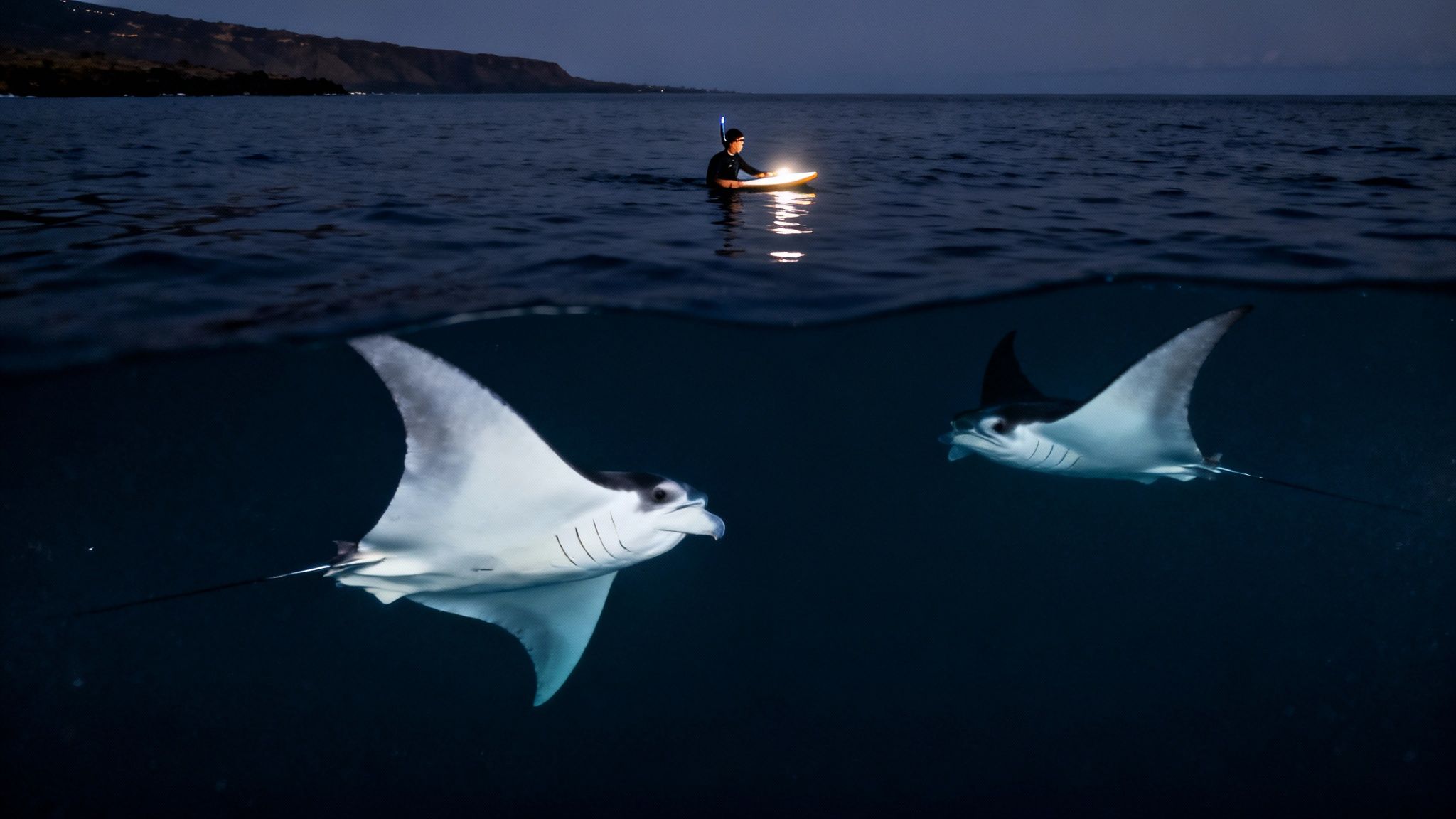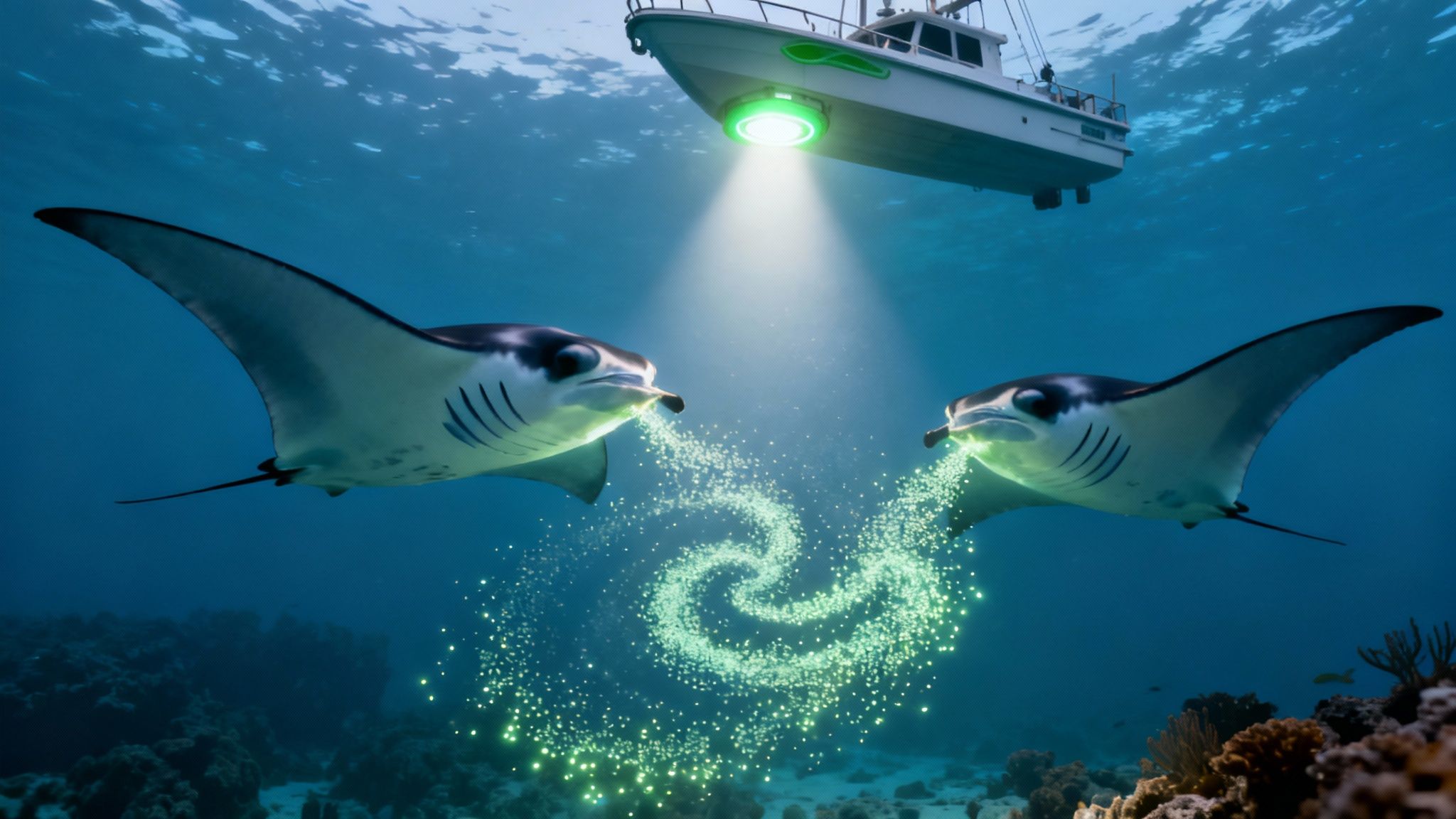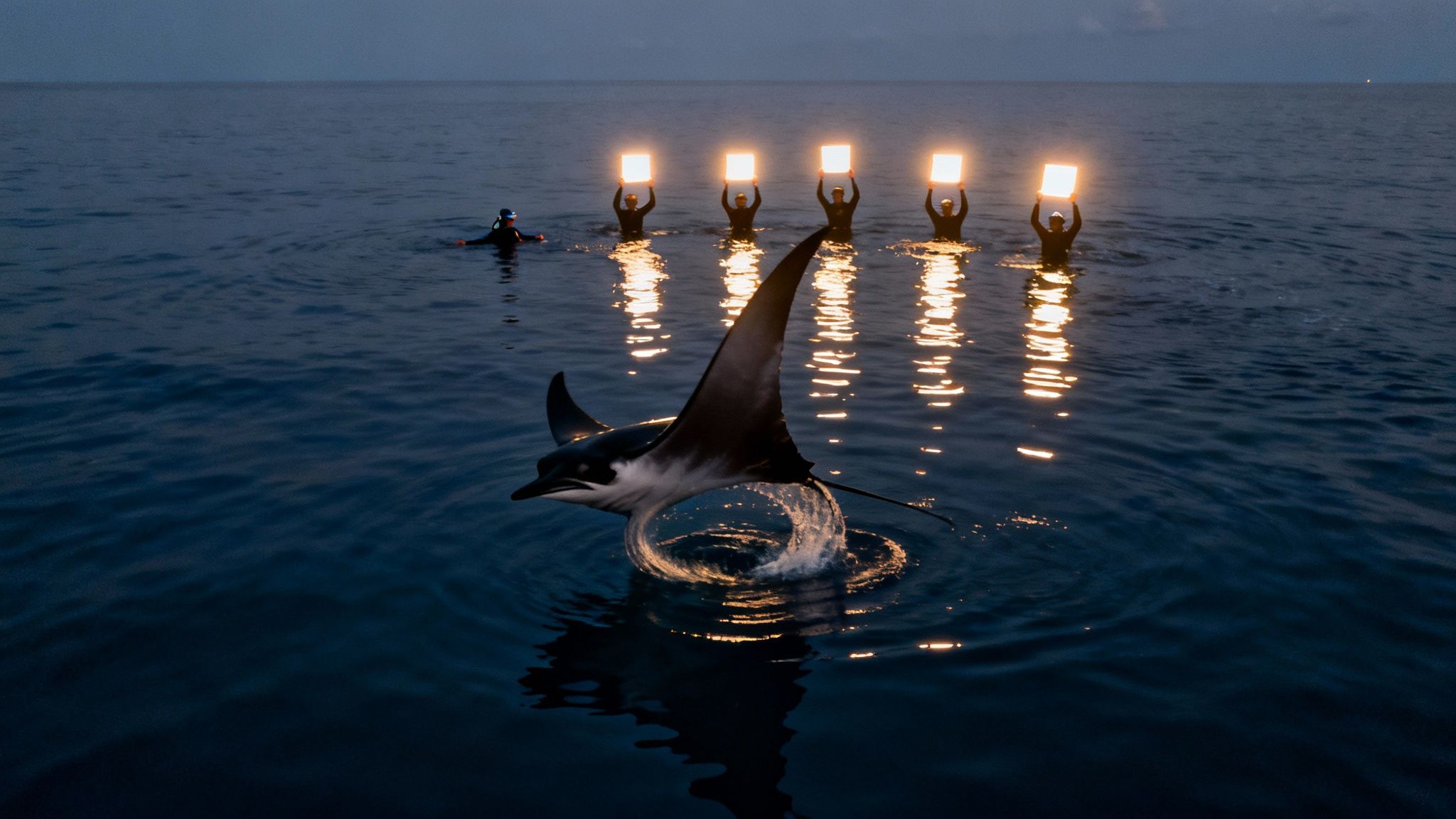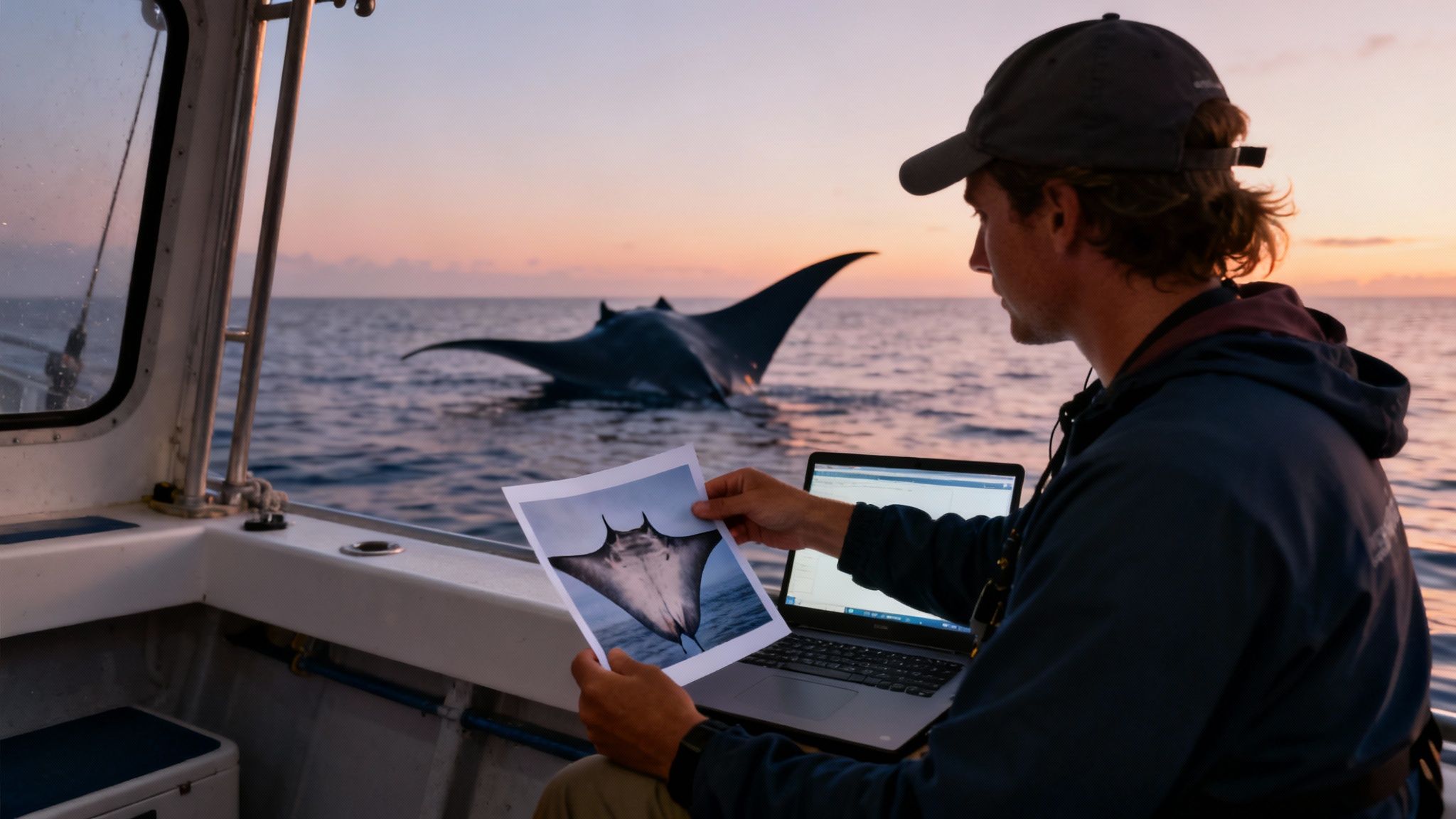Manta Ray Snorkel Big Island A Complete Guide
- Byron
- 22 minutes ago
- 13 min read
Picture this: you're floating in the warm, dark Pacific Ocean, looking down into a cone of light. Suddenly, a giant, otherworldly shape glides silently into view, its white belly glowing as it soars through the illuminated water. This isn't a scene from a sci-fi movie; it's the very real, very magical experience of a manta ray snorkel on the Big Island.
This incredible encounter is consistently voted one of the best wildlife experiences on the planet. For a complete look at this bucket-list adventure, visit our homepage at Manta Ray Night Snorkel Hawaii.
Experience the Magic of a Manta Ray Snorkel

The Kona coast has become world-famous as the place to see these gentle giants up close. This isn't just a lucky sighting; it's a nightly spectacle that happens thanks to a perfect blend of biology and responsible tourism. This guide will give you the inside scoop on how to plan a trip that's ethical, safe, and absolutely unforgettable.
If you're searching for an exceptional alternative for a Manta Ray night snorkel tour or a great Captain Cook snorkeling tour, many people have incredible experiences with Kona Snorkel Trips. They're known for their commitment to smaller groups and sustainable practices, which makes for a much more personal and respectful adventure.
Why Is This Experience So Special?
This is so much more than just looking at fish. It's like having a front-row seat to an underwater ballet, and you're floating right above the stage. People often describe the experience as otherworldly, as these "sea angels" perform graceful, acrobatic barrel rolls just inches beneath you. It’s a peaceful, awe-inspiring, and surprisingly emotional activity that’s perfect for almost any age or swimming ability.
The feeling of watching a massive fish the shape of a stealth bomber coming into vision is impossible to describe. It’s akin to watching your child ride a bike for the first time or finding a winning lottery ticket.
So, how does this happen every single night? It all comes down to a simple, brilliant connection: light attracts plankton, and plankton is what manta rays eat. Tour operators anchor a custom-built light board on the ocean floor, which acts like a giant beacon. This light draws in clouds of plankton, creating a reliable "dinner buffet" that the mantas can't resist.
A Model for Ecotourism
What's happening on the Kona Coast is a fantastic example of ecotourism done right. The activity brings in over $10 million in annual bookings from around 80,000 participants each year. This not only supports local businesses but also funds crucial conservation work.
Researchers have been tracking and photo-identifying individual rays like "Lefty" and "Big Bertha" since 2009. The data is incredible—they consistently see between 50 to 150 different mantas at each site per month, and the encounter rate for snorkelers stays steady at an amazing 85-90%. These statistics prove that Kona's conservation-first model has made it the world's premier destination for manta ray research and tourism.
As you get ready for this once-in-a-lifetime encounter, you might want to brush up on a few tips to improve your photography composition to capture the moment. Sharing your photos helps spread the word about how incredible these creatures are and why they're worth protecting.
Why Kona Is a Manta Ray Magnet

So, what makes the Kona coast the world’s most reliable spot for a manta ray snorkel on the Big Island? It’s not just pure luck. It's a surprisingly simple and brilliant combination of biology and a little human ingenuity. The secret is basically sending out the perfect dinner invitation that these gentle giants just can't turn down.
The whole thing is often called the "manta campfire," and that’s a perfect way to think about it. Just like moths flocking to a porch light, the manta rays are drawn to a man-made light source. Tour operators figured out they could attract mantas by shining powerful, eco-safe lights into the water right after sunset.
These bright lights act like a magnet for zooplankton—the tiny, microscopic critters that are the foundation of the ocean's food web. As the plankton swarm to the light, they create a thick, irresistible buffet. That concentrated cloud of food is exactly what brings the manta rays in for their spectacular nightly feeding ballet.
Meet the Gentle Giants
The stars of this incredible show are the resident reef manta rays, or Manta alfredi if you want to get scientific. They're the second-largest ray species on the planet and are truly a sight to behold.
With wingspans that can stretch up to 18 feet, they glide through the water with a grace that seems impossible for their size. Most of the mantas you'll meet in Kona are still incredibly impressive, averaging a wingspan of around 12 feet. And despite their massive presence, they are completely harmless filter-feeders with no teeth, stingers, or barbs.
One of the coolest facts about reef mantas is the unique pattern of black spots on their white bellies. Just like a human fingerprint, no two patterns are alike. This allows researchers and local guides to identify, name, and track individual rays over decades.
This personal connection makes the whole experience feel even more special. You'll likely hear your guide call out a regular visitor by name, sharing stories about its personality and history. It's a testament to the really positive relationship that has been built between the local community and these amazing animals.
A Thriving and Well-Studied Population
The Kona Coast is home to a healthy and well-documented manta ray population of over 450 identified individuals. This thriving community is a huge reason why the nightly encounters are so consistent. Years of scientific observation and video have given us a detailed understanding of their social behaviors, which are still being studied today.
Because the lights create such a reliable feeding spot, tour operators can boast a remarkable 85-90% sighting success rate all year long. It’s what makes Kona a top-tier global destination for manta experiences. You can dive deeper into the data and learn more about this unique population from the folks at Manta Ray Advocates.
When choosing a tour, it’s always a good idea to pick one that respects this incredible ecosystem. For a fantastic alternative, whether you want a Manta Ray night snorkel or a beautiful daytime adventure like a Captain Cook snorkeling tour, many visitors love the small-group experience offered by Kona Snorkel Trips. Their focus on responsible tourism helps ensure these magical encounters can continue for years.
How to Choose Your Manta Ray Snorkel Tour
Picking the right tour is easily the most important decision you'll make when planning your manta ray snorkel on the Big Island. It really sets the tone for the entire experience, from how comfortable you are on the water to how up-close-and-personal you get with the rays. It’s a bit like choosing between a massive stadium concert and a small, acoustic show—both can be amazing, but the vibe is completely different.
To make sure you have the best night possible, you’ll want to weigh a few key things before you click that “book” button. The boat size, the departure time, and especially the company's commitment to the manta rays' well-being will make or break your adventure. Getting this part right is the difference between a good trip and a truly unforgettable one.
Comparing Boat Sizes: Large Vessels vs. Small Rafts
One of the first choices you'll face is the type of boat that will take you out to the manta site. The two main options are polar opposites, and each offers its own unique experience.
Large, stable catamarans are a fantastic pick for families, first-time snorkelers, or anyone who’s a bit anxious about being on the open ocean after dark. These boats usually come with more creature comforts, like onboard bathrooms and plenty of deck space, making the ride smooth and comfortable. Their stability is also a huge bonus if you're worried about seasickness.
On the flip side, smaller boats, like the rigid-hull inflatable rafts (you'll often hear them called Zodiacs), offer a more intimate, thrill-seeking kind of adventure. With far fewer people on board, you get a much more personal tour and more facetime with your guides. The ride itself is half the fun—it’s faster, bumpier, and puts you right down close to the water, which many people find exhilarating.
The right boat really just comes down to your group’s personality and comfort level. A family with young kids will probably love the stability of a big catamaran, while a couple of adventurers might get a kick out of the zippy raft ride.
Finding an Exceptional Tour Operator
When you're ready to look at specific companies, Kona Snorkel Trips is an exceptional choice for a Manta Ray night snorkel. They also run beautiful daytime trips, like their famous Captain Cook snorkeling tour. They've built a stellar reputation for their experienced crews and their focus on responsible, small-group tourism, which helps create a more respectful and personal encounter with the rays.
Timing Your Tour: Sunset vs. Late Evening
Another big decision is when to go. Most tour operators offer at least two main departure times: a sunset trip and a later one after dark.
Sunset Tours: These are the most popular, and for good reason. You get to watch a spectacular Kona sunset from the boat on your way out to the snorkel spot. It’s an absolutely beautiful start to the evening.
Later Evening Tours: These "after dark" trips often mean fewer boats at the manta site, which can lead to a less crowded experience in the water. As a bonus, the ride back to the harbor under a sky full of stars is just breathtaking.
The mantas feed all evening long, so your chances of seeing them are excellent no matter which time you pick. It really just boils down to personal preference: do you want a scenic sunset cruise or a quieter, starlit swim? For a deeper dive into this, check out our ultimate guide to the best manta ray snorkel Kona tours.
The Most Important Factor: Sustainability
More than anything else, choosing a sustainable operator is what truly matters. The health and safety of these gentle giants depend entirely on tour companies following responsible, established guidelines. Look for operators who are on the Manta Ray Green List and practice passive observation.
This means a few very important things:
No Touching: Guides must be strict about the "no touching" rule. Touching a manta ray can damage the delicate mucous coating that protects it from infection.
Passive Observation: You should always stay on the surface, holding onto a light board. Never dive down to chase or get in the way of the mantas.
Educational Briefing: A great tour always starts with a thorough briefing about manta ray biology and the right way to interact with them respectfully.
Your choice has a direct impact. By booking with a company that puts the mantas' well-being first, you're helping to protect this incredible marine ecosystem for years to come.
What Happens on a Night Snorkel Adventure

So, you've picked a tour and you're getting ready for one of the most incredible experiences of your life. Let's walk through what a typical manta ray snorkel on the Big Island actually feels like, from the moment you meet the crew to your last glimpse of these gentle giants. Knowing what to expect helps calm any pre-snorkel jitters so you can just soak it all in.
Your evening will likely start at the harbor, where you’ll check in and meet the crew and your fellow adventurers. There's always a buzz of excitement in the air. The boat ride out to the manta site is part of the fun, often timed to catch a spectacular Kona sunset lighting up the sky.
As you cruise along the coast, the crew will give you a very important safety briefing. This isn't just about rules; it's a quick lesson in manta ray etiquette. They'll tell you a bit about manta biology and, most importantly, explain the golden rule of passive observation—which means looking but never, ever touching these amazing animals.
Getting Into the Water
Once the boat anchors, the real magic begins to build. The crew sets up a large, custom-made light board that floats on the surface. This is your personal viewing platform for the night. You're not just swimming around in the dark; you'll get in the water and hold onto this buoyant, illuminated raft.
This light board has a brilliant purpose: its powerful lights shine down into the water, attracting huge clouds of plankton. Think of it as a dinner bell for manta rays. You'll be geared up with a wetsuit to stay warm, a mask, and a snorkel.
Slipping into the dark ocean at night might sound a little intimidating, but the water is usually quite calm. The brightly lit area around the board creates a safe, contained space—like you're floating in your own private, open-ocean aquarium.
Before long, you'll see the first ghostly shapes emerge from the darkness below. One manta ray might glide into the light, then another, and then more. They come to feast on the plankton, performing graceful, acrobatic barrel rolls just inches beneath you. Having a creature with a 12-foot wingspan soar right under you is a moment that will be etched in your memory forever.
What to Wear and Bring
Coming prepared is the key to staying comfortable so you can fully enjoy the show. Even in Hawaii, the water can get chilly after a while, and the boat ride back can feel cool and breezy.
Here’s a simple checklist of what you should pack:
A Towel and a Change of Clothes: You’ll be so glad to have something warm and dry to change into for the ride back to the harbor.
A Windbreaker or Jacket: The ocean breeze feels much colder when you're wet. This is a non-negotiable for staying comfortable.
Reef-Safe Sunscreen: If you're on a sunset tour, put this on before you get on the boat to protect your skin and our fragile coral reefs.
Gratuity for the Crew: If you have an amazing time, it's customary to tip your guides and captain for their hard work and expertise.
Most tours provide snacks and drinks, but it never hurts to double-check when you book. For a deeper dive into how to prepare, check out our complete guide to night snorkeling with manta rays.
The whole encounter is a beautifully managed event that puts you right in the middle of a natural feeding frenzy without disrupting it. By listening to your crew and packing the right gear, you’re all set for a night you’ll never forget.
Protecting the Gentle Giants of Kona

The Kona manta ray encounter is one of the world's best examples of ecotourism in action. But keeping it that way depends entirely on everyone doing their part. This incredible experience is built on a foundation of deep respect for the animals and their home. Protecting these gentle giants is a shared responsibility, falling on both the tour operators and every single visitor who floats in the water with them.
The heart of this conservation effort is simple: passive observation. Think of yourself as a silent, respectful guest at their underwater dinner party. This one principle guides everything about a responsible manta ray snorkel on the Big Island.
The Rules of Respectful Viewing
The guidelines are straightforward and exist to keep both you and the mantas safe. By following them, we ensure the animals stay comfortable and continue visiting these feeding sites for years to come. The number one rule is to never, ever touch, chase, or try to ride a manta ray.
A manta’s skin is covered in a delicate mucus layer that acts as its immune system, shielding it from bad bacteria. Touching them can strip this protective coat right off, leaving them wide open to dangerous infections. Snorkelers also need to stay on the surface, holding onto the light board, and never dive down toward the mantas.
The goal is to be a floating observer, not an active participant. By staying calm and still, you allow the mantas to feel secure, which often results in them gliding even closer as they feed.
Understanding the Threats Mantas Face
Away from the snorkel sites, manta rays face serious threats out in the open ocean. Getting tangled up in old fishing gear and being hit by boats are two of the biggest dangers they face. As smart, curious animals, they can easily get caught in nets and lines, leading to severe injury or even death.
Recent genetic studies have shown just how fragile these populations really are. Research has found that Hawaii’s reef mantas live in small, isolated communities. The Big Island's entire breeding population is estimated to be only about 104 adults. Because females give birth to just one pup every two to three years, these tiny, unique groups need very specific, island-focused conservation efforts to survive.
Just as we must protect the mantas, it’s important to understand the regulations for interacting with protected natural environments wherever our travels take us.
Your Role in Manta Ray Conservation
The single most important thing you can do is choose a certified, eco-conscious tour operator. These companies have a vested interest in the long-term health of the manta population and actively contribute to conservation. They build their entire business around these principles, creating a sustainable and respectful experience for everyone.
When you book with a responsible company, your trip becomes more than just a tour—it becomes a direct contribution to the research, advocacy, and education that helps Kona's manta rays thrive. By being a thoughtful visitor, you play a crucial role in maintaining the delicate balance that makes this underwater ballet possible.
Your Manta Ray Snorkel Questions Answered
So, you're getting excited about the idea of a manta ray snorkel on the Big Island. That's fantastic! But it's totally normal to have a few questions pop into your head before diving into a unique adventure like this one.
We get it. You want to feel completely prepared and confident. Let's walk through some of the most common questions we hear, so you can put any worries to rest and just look forward to the experience.
Is It Safe to Swim with Manta Rays at Night?
Yes, 100%. This is one of the safest and most gentle wildlife encounters you can imagine. Manta rays might look huge and imposing, but they are truly gentle giants.
These magnificent creatures are filter feeders, meaning they don't have teeth. They also lack any stingers or barbs, so they pose absolutely no threat to humans. Your guides are trained experts who make safety their top priority, providing wetsuits and flotation devices to keep you comfortable and secure on the water's surface.
What Happens If No Manta Rays Show Up?
This is a great question. While the odds are overwhelmingly in your favor—the sighting rate is consistently above 90%—we are dealing with wild animals. On very rare nights, they might decide to dine elsewhere.
In that unlikely event, nearly every reputable tour company has a "manta guarantee." This usually means you can come back another night for a second chance, completely free of charge. This is a solid reason to book your snorkel for one of your first nights on the island, leaving you with backup options if needed. Just be sure to double-check the specific policy when you book your tour.
Is There a Best Time of Year to See Mantas?
Nope! This is one of the best parts about the Kona manta ray snorkel—there's no "bad" time to go. The mantas here are a resident population, meaning they hang out along this coastline all year long.
They don't migrate, so their nightly plankton buffet happens every single night, regardless of the season. You can plan your trip for January or July and have an equally amazing chance of seeing a spectacular underwater ballet.
The experience is consistent throughout the year, making it one of the most reliable and accessible world-class wildlife encounters. Your decision on when to visit can be based on weather, crowds, and your own schedule.
Hopefully, that clears things up! If you have more questions buzzing in your mind, this comprehensive manta ray FAQ is an excellent resource. Now, you should be all set for an incredible night with Kona's gentle giants.
Comments